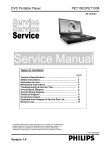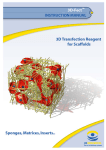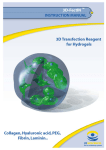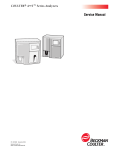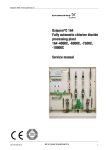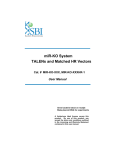Download PolyMag/Neo & CombiMag
Transcript
Magnetofection: PolyMag/Neo & CombiMag Instruction Manual Magnetofection is a novel, simple and highly efficient in vitro and in vivo transfection method * List of Magnetofection™ Kits 1 2 3 4 5 6 7 8 Catalog Number Description 100 200 1000 Size (number of transfections / µg of DNA) 100 200 1000 Number of transfections / 96 well plates 1000 2000 10000 PN30100 PN30200 PN31000 PolyMag reagent PolyMag reagent PolyMag reagent PG60100 PG60200 PG61000 PolyMag neo reagent PolyMag neo reagent PolyMag neoreagent 100 200 1000 100 200 1000 1000 2000 10000 CM20100 CM20200 CM21000 CombiMag reagent CombiMag reagent CombiMag reagent 100 200 1000 100 200 1000 1000 2000 10000 KM30200 KM30300 KM30350 KM30400 Selection Kit 1 Selection Kit siP 2 Selection Kit siC 3 Super Selection Kit 3 x 100 200 + 2 x 100 200 + 100 200 + 3 x 100 200 200 2000 400 - 1000 400 - 1000 400 - 2000 KC30200 KC30400 KC30296 KC30496 Magnetofection Starting Kit Super Starting Kit 6 Magnetofection Starting Kit Super Starting Kit 8 3 x 100 200 + 3 x 100 3 x 100 200 + 3 x 100 200 200 200 200 2000 400 - 2000 2000 400 - 2000 MF10000 MF14000 MF10096 Super Magnetic Plate Mega Magnetic Plate 96-Magnets, Magnetic Plate N/A N/A N/A N/A N/A N/A N/A N/A N/A Contains Contains Contains Contains Contains Contains Contains Contains 1 1 1 1 1 1 1 1 vial vial vial vial vial vial vial vial of of of of of of of of each each each each each each each each reagent reagent reagent reagent reagent reagent reagent reagent Volume (µL) 4 5 7 (PolyMag, PolyMag Neo and CombiMag) (SilenceMag, PolyMag and PolyMag Neo) (SilenceMag and CombiMag) (SilenceMag, PolyMag, PolyMag Neo & CombiMag) (PolyMag, PolyMag Neo and CombiMag) plus a Super Magnetic Plate (MF10000) (SilenceMag, PolyMag PolyMag Neo & CombiMag) plus a Super Magnetic Plate (MF10000) (PolyMag, PolyMag Neo and CombiMag) plus a 96-magnets Magnetic Plate (MF10096) (SilenceMag, PolyMag, PolyMag Neo & CombiMag) plus a 96-magnets Magnetic Plate (MF10096) Use the content of the table above to determine the appropriate catalog number for your needs. You can order these products by contacting us (phone, fax, email, website). For all other supplementary information, do not hesitate to contact our dedicated technical support ([email protected]) and/or to visit our website: www.ozbiosciences.com. OZ BIOSCIENCES Parc Scientifique et Technologique de Luminy Zone entreprise, case 922 - 13288 Marseille Cedex 9, France Tel: +33 (0) 4.86.94.85.16 /Fax: +33 (0) 4.86.94.85.15 E-mail: [email protected] Site Internet: www.ozbiosciences.com OZ Biosciences / Protocol Magnetofection / www.ozbiosciences.com / -1- Table of Contents 1. Technology 1.1. Description 1.2. Available Reagents 1.3. Kit Contents 2. Applications 2.1. Nucleic Acids Dose Response and Transfection Kinetics 2.2. Nucleic Acids Types and Vectors 2.3. Cell Types 3. Magnetofection Apparatus 4. Protocols 4.1. General Considerations 4.2. General Protocol 4.3. PolyMag or PolyMag Neo 4.4. CombiMag 4.5. Magnetofection of Suspension Cells 5. Appendix 5.1. Protocol Optimization 5.2. Protocol Optimization in a 96-well format 5.3. Quality Controls 5.4. Troubleshooting 6. Related Products 7. Purchaser Notification 3-4 3 4 4 4-5 4 5 5 5 6-8 6 6 6 7 8 8-11 8 9 10 11 11 11 1. Technology 1.1. Description Congratulations on your purchase of the Magnetofection reagent! Magnetofection™ is an original, simple and highly efficient method to transfect cells in culture and in vivo. It exploits magnetic force exerted upon gene vectors associated with magnetic particles to drive the vectors towards, possibly even into, the target cells. In this manner, the complete applied vector dose gets concentrated on the cells within a few minutes so that 100% of the cells get in contact with a significant vector dose. This has several important consequences: 1. Greatly improved transfection rates in terms of percentage of cells transfected compared to standard transfections. 2. Up to several thousand folds increased levels of transgene expression compared to standard transfections. 3. High transfection rates and transgene expression levels are achievable with extremely low vector doses, which allow saving expensive transfection reagents. 4. Extremely short process time in comparison to standard procedures. A few minutes of incubation of cells with gene vectors are sufficient to generate high transfection efficiency. Based upon a validated and recognized magnetic drug targeting technology, this innovative method is: • Efficient, simple & rapid • Multipurpose (for all types of nucleic acids and non-viral vectors) • Universal (primary cells and cell lines) • Non toxic & economical OZ Biosciences / Protocol Magnetofection / www.ozbiosciences.com / -2- 1.2. Available Reagents OZ Biosciences offers three types of ready-to-use Magnetofection transfection reagents: 1. PolyMag is a universally applicable magnetic particle preparation for high efficiency nucleic acid delivery. Nucleic acids to be transfected and the magnetic particles are mixed in a one-step procedure. PolyMag has been used successfully with plasmid DNA, antisense oligonucleotides and siRNA. 2. PolyMag Neo is an optimized formulation of PolyMag for a higher gene expression level in primary, hard-totransfect and cell lines. 3. CombiMag is a magnetic particle preparation designed to be combined with any commercially available transfection reagent such as cationic polymers and lipids. CombiMag has been used successfully with plasmid DNA, antisense oligonucleotides, mRNA and siRNA Other Magnetofection based reagents have been developed by OZ Biosciences. SilenceMag: specifically designed for siRNA delivery, ViroMag & ViroMag R/L: specially developed for all viral applications and NeuroMag: created to achieve efficient transfection of primary neurons and neuronal cell lines. Further detailed information on these specifics reagents can be found at: www.ozbiosciences.com 1.3. Kit Contents Kit contents differ according to their size 1 tube containing 100 µL of particle suspension good for 100 transfections with 1 µg of DNA 1 tube containing 200 µL of particle suspension good for 200 transfections with 1 µg of DNA 1 tube containing 1000 µL of particle suspension good for 1000 transfections with 1 µg of DNA Stability and Storage Storage: +4ºC. Upon receipt and for long-term use, store all reagent tubes in the fridge. Magnetofection kits are stable for at least one year at the recommended storage temperature. • • DO NOT FREEZE THE MAGNETIC NANOPARTICLES! DO NOT ADD ANYTHING TO THE STOCK SOLUTION OF NANOPARTICLES! Shipping condition: Room temperature 2. Applications 2.1. Nucleic Acids Dose Response and Transfection Kinetics Save Times response (expression level) paramagnetic vehicle plus magnetic field 150 paramagnetic vehicle no magnetic field 100 standard gene transfer 50 0 0 0.05 0.1 0.15 dose (µg DNA) DNA dose response profile. NIH-3T3 cells were transfected with a commercial transfection reagent L +/- CombiMag with and without the magnetic field for 15 min. Luciferase expression was assayed after 24h. response (expression level) Save Materials 200 300 200 100 0 0 50 100 150 200 250 process time (min) Transfection kinetics. NIH-3T3 cells were incubated with a commercial transfection reagent G ± CombiMag with and without the magnetic field for the indicated time spans. Luciferase expression was assayed after 24h. OZ Biosciences / Protocol Magnetofection / www.ozbiosciences.com / -3- 2.2. Nucleic Acids Types and Vectors The CombiMag reagent can be combined with any nucleic acid and all transfection reagents. Nucleic Acid or Virus DNA (plasmid) Antisense Oligonucleotides mRNA siRNA Viruses PolyMag PolyMag Neo CombiMag SilenceMag ViroMag √ √ √ √ √ √ √ √ √ NA NA NA NA NA NA NA NA √√ NA √√ 2.3. Cell Types Magnetofection is applicable with numerous cell types and has been successfully tested on a variety of immortalized cell lines as well as primary cells (see list on website). If a particular cell type or cell line is not listed, this does not imply that Magnetofection is not going to work. An updated list of cells successfully tested as well as product citations is available on the website: www.ozbiosciences.com. For the cells listed, some reagents have not been tested so far, as indicated by ″n.d.″ (not determined). 3. Magnetofection Apparatus Apart from suitable magnetic nanoparticles, Magnetofection requires appropriate magnetic fields. A magnetic plate especially designed for Magnetofection is provided to exert these specific magnetic fields. Its special geometry not only produces strong magnetic fields under each well of 96-well plates but is also applicable for other plate formats (T-75 flasks, 60 & 100 mm dishes, 6-, 12- and 24-well plates). Super Magnetic Plate suits for all cell culture supports and Mega Magnetic Plate is designed to hold up to 4 culture dishes at one time. The magnetic plate design allows producing a heterogeneous magnetic field that magnetizes the nanoparticles in solution, forms a very strong gradient and covers all the surface of the plate. Magnetic plate 96 magnets Super Magnetic Plate Mega Magnetic Plate OZ Biosciences / Protocol Magnetofection / www.ozbiosciences.com / -4- 4. Protocols 4.1. General Considerations Instructions given below represent sample protocols that were successfully applied with a variety of cell lines. Optimal conditions do vary from cell line to cell line and are dependent on nucleic acid, transfection reagent or virus used. Consequently, the amounts and ratio of the individual components (DNA and reagents) may have to be adjusted to achieve best results. Therefore, we advise you to optimize the various transfection or infection parameters (components concentration, cell number, incubation time…). Several protocol optimizations are available in the Appendix and upon request by email. The following recommendations can be used as guidelines to achieve good transfection with minimal incubation times. 4.2 General Protocol It is recommended to seed or plate the cells the day prior transfection. The suitable cell density will depend on the growth rate and the cells conditions. Cells should be 60-90% confluent at the time of Magnetofection (see the suggested cell number in the table below). For suspension cells, use the specific protocol given below. Immediately preceding transfection, the medium can be replaced with fresh medium (optionally without serum) if necessary. Cell Number and Transfection Volume Suggested Tissue Culture Dish Cell Number DNA Quantity Transfection Volume (µg) 4 96 well 0.5 – 2 x 10 0.1 – 0.5 200 µL 24 well 0.5 – 1 x 10 5 0.5 - 2 500 µL 2-4 1 mL 12 well 1 – 2 x 10 5 2-6 2 mL 6 well 2 – 4 x 10 5 6-8 4 mL 60 mm dish 5 – 10 x 10 5 8 - 12 8 mL 90 - 100 mm dish 10 – 20 x 10 5 10 - 20 12 mL T-75 flask 20 – 50 x 10 5 The same protocol can be used to produce stably transfected cells except that 48 hours post transfection fresh medium containing the appropriate antibiotics are transferred to cells for selection. It is important to wait at least 48 hours before exposing the transfected cells to selection media. Vectors are prepared in medium without serum and supplement or in physiological saline buffer. According to the standard Magnetofection protocol, the serum- and supplement-free vector cocktail is added to the cells that are cultured in complete medium. Therefore, the addition of the transfection solution will result in the dilution of standard culture medium. For most cell types, a medium change is not required after Magnetofection. However, it may be necessary for cells that are sensitive to serum/supplement concentration. Alternatively, the cells may be kept in serum-free medium during Magnetofection (up to 4 hours). In this case, a medium change will be required after Magnetofection. 4.3. PolyMag or PolyMag Neo The protocol is as simple as follows: use 1 µL of PolyMag or PolyMag Neo per µg of DNA. 1) Before each use, vortex the PolyMag or PolyMag Neo material. Add 1 to 10 µL of PolyMag or PolyMag Neo (according to the DNA amount) to a microtube or to a microwell (U-bottom well is preferred to get a better mixing). If required and for doses less than 1 µL, predilute PolyMag or PolyMag Neo with deionized water. 2) Dilute 1 to 10 µg of DNA to 200 µL with serum and supplement-free culture medium (such as DMEM). 3) Add the 200 µL DNA solution to the PolyMag or PolyMag Neo solution and mix immediately by vigorous pipetting. 4) After 20 to 30 minutes of incubation, add the 200 µL of complexes to the cells. The total transfection volumes per well (culture medium + PolyMag or PolyMag Neo mixture) are suggested in the table above. Note: to transfect cells in duplicate prepare your DNA/PolyMag or PolyMag Neo complexes as described previously and transfer 100 µL of the resulting mixture to each well containing the cells to be transfected. OZ Biosciences / Protocol Magnetofection / www.ozbiosciences.com / -5- 5) Place the cell culture plate upon the magnetic plate for 5 to 20 minutes. 6) Optionally perform a medium change. Remove the magnetic plate. 7) Cultivate the cells under standard conditions until evaluation of transgene expression. For siRNA application, we recommend the use of SilenceMag. 4.4. CombiMag Until now, a universal method enhancing the efficiency of synthetic (non-viral) gene delivery systems was lacking. Magnetofection is the only existing method answering these needs. The conducted studies have shown that Magnetofection: • Increases the efficiencies of commercial transfection reagents & reduces the required DNA doses. • Significantly improves the efficiencies of all types of nucleic acids delivered. A number of suppliers sell transfection reagents. They all can be associated with CombiMag by simple mixing in order to generate magnetic delivery system. The resulting mixture leads to strong efficiency improvements for commercial transfection reagents. This solution allows you to create your magnetic gene vector. There are two strategies of using CombiMag: - One is to prepare a standard complex of DNA and a commercial transfection reagent according to the instructions of the manufacturer, followed by mixing with CombiMag. - The second strategy is to first mix DNA and CombiMag followed by immediate mixing with the transfection reagent. In this case, the manufacturer’s instructions are used except that instead of DNA alone, a mixture of DNA and CombiMag is added to the transfection reagent. Depending on the transfection reagent used, the mixing order of components may influence the final transfection efficiency of Magnetofection. It is recommended to use 1 or 2 µL of CombiMag per µg of DNA in initial experiments. However, depending on the cell line to be transfected and the commercial transfection reagent used, the optimal composition may be found above or below this ratio. 1) Before each use, vortex the tube of CombiMag. Add 1 or 2 µL of CombiMag per µg of DNA to be transfected to a microtube. For DNA doses of less than 1 µg predilute an aliquot of CombiMag reagent with deionized water and use the volume required for your DNA dose. 2) Prepare the DNA / transfection reagent complexes according to the reagent’s manufacturer instructions, but omit the usual final incubation step after mixing DNA & reagent and immediately proceed to step 3. 3) Add the DNA / transfection reagent complex solution into the CombiMag suspension and mix immediately by vigorous pipetting. 4) Incubate for 15 - 30 minutes. 5) Add the resulting mixture to the cells to be transfected. Note: to transfect cells in duplicate prepare your DNA/transfection reagent complexes as described above. If the complexes have been prepared in 200 µL, then transfer 100 µL of the resulting mixture in each well containing the cells to be transfected. The total transfection volume / per well (culture medium + CombiMag mixture) are suggested in the table above. 6) Place the cell culture plate upon the magnetic plate for 5 to 20 minutes. 7) Optionally perform a medium change. Remove the magnetic plate. For viral application, we recommend the use of ViroMag or ViroMag R/L. Note: For certain cells (primary cells such as neurons), a medium change at this step significantly improves the transfection efficiency and greatly minimizes potential cytotoxicity. To process the medium change, leave the cells onto the magnetic plate, remove the culture medium and replace it with fresh culture complete medium. Thereafter, remove the magnetic plate and continue to step 8 below. 1) Cultivate the cells under standard conditions until evaluation of transgene expression. 2) Depending on the commercial transfection reagent used, this protocol may have to be adapted. For viral application, we recommend the use of ViroMag or ViroMag R/L. OZ Biosciences / Protocol Magnetofection / www.ozbiosciences.com / -6- 4.5. Magnetofection of suspension cells 1) The composition and preparation of PolyMag or PolyMag Neo / DNA or CombiMag / transfection reagent are performed exactly as described above from steps 1 to 3. 2) While PolyMag or PolyMag Neo / DNA or CombiMag / transfection reagent are incubating (step 4 above), dilute the cells to be transfected to 5 x 105 - 1 x 106 / mL in medium (with or without serum- or supplement; depending on cell type and sensitivity of cells towards serum-free conditions) and perform one of the following three options to sediment the cells at the bottom of the culture dish in order to promote the contact with the magnetic nanoparticles. a. Seed the cells on polylysine-coated plates and use the protocol for adherent cells. OR b. Briefly, centrifuge the cells (2 minutes) to pellet them and use the protocol for adherent cells. OR c. Mix cell suspension with 30 µL of CombiMag reagent per mL of cell suspension. i. Incubate for 10 - 15 minutes. ii. Distribute cells to your tissue culture dish placed upon the magnetic plate (volume of culture medium containing cells depends on the culture dish size; see suggested transfection volume in table above as indication). iii. Incubate for 15 minutes OR d. Incubate the cells in serum free medium during 2 hours prior Magnetofection. The absence of serum allows some cells to adhere onto the plastic dish surface. 3) Add the resulting mixture of PolyMag or PolyMag Neo / DNA or CombiMag / transfection reagent to the cells while keeping the cell culture plate on the magnetic plate. 4) Incubate for 15 minutes. 5) Carefully remove the medium supernatant from the cells and replace with fresh complete medium while the culture plate remains positioned on the magnetic plate. Be careful not to aspirate the magnetically sedimented cells. 6) Remove culture plate from magnetic plate. 7) Continue to cultivate cells as desired until evaluation of transgene expression. 5. Appendix 5.1. Protocol Optimization We strongly advise you to optimize your transfection and/or infection conditions in order to get the best out of Magnetofection. Several parameters can be optimized: • Nucleic acid dose used • Ratio of CombiMag / PolyMag or PolyMag Neo to nucleic acid • Cell density • Incubation time OZ Biosciences team has investigated numerous factors during the course of the R&D program. Based on our experience, we recommend that you to optimize one parameter at a time and start from the experimental procedures described above in section 4. 1) Start by optimizing the ratio PolyMag or PolyMag Neo / DNA or CombiMag / transfection reagent. To this end, use a fixed amount of DNA. Vary the amount of CombiMag or PolyMag or PolyMag Neo from 0.25 to 5µL / µg of DNA. The ratio PolyMag, PolyMag Neo or CombiMag / DNA can be changed by doubling or multiplying the volumes of the reagents used. Reagents can be pre-diluted in deionized water and aliquots of the resulting dilutions are incubated with DNA or pre-formed DNA complexes. Finally, the different components can be serially diluted to very low concentrations. OZ Biosciences / Protocol Magnetofection / www.ozbiosciences.com / -7- 2) Thereafter, change the nucleic acid dose with a fixed ratio of PolyMag or PolyMag Neo / DNA or CombiMag / transfection reagent that has been previously optimized. For this purpose, you can perform a serial dilution of a preformed magnetic vector complex. 3) After having identified the correct quantity of CombiMag / PolyMag or PolyMag Neo, nucleic acid, transfection reagent (commercial), you could pursue the process by optimizing the cell number as well as the incubation times for the complex formation and for the magnetic field application. 5.2. Protocol Optimization in a 96-well format Adherent cells For adherent cells, seed the cells at the desired density in a 96- well plate the day prior or at least several hours prior transfection in a total of 150 µL medium per well. 1) In four tubes, dilute 7.2 µg of DNA (or DNA-transfection reagent complex) each to 346 µL with serum- and supplement-free medium (e.g. DMEM). 2) Provide 3.6, 7.2, 10.8 and 14.4 µL, respectively, of PolyMag or PolyMag Neo (in case of DNA) or CombiMag (in case of DNA-transfection reagent complex) in well A1, A4, A7 and A10, respectively, of a 96-well plate. 3) Add the 346 µL of DNA solution (or DNA-transfection reagent complex) from step 1 to wells A1,A4, A7 and A10, respectively, containing PolyMag, PolyMag Neo or CombiMag and mix well by pipetting. 4) Fill up to 360 µL with serum- and supplement-free medium (e.g. DMEM) by adding 10.4 µL to A1, 6.8 µL to A4 and 3.2 µL to A7. 1 1 2) 3) 4) 6) 7) 2 3 2 3 4 5 6 7 8 9 10 11 12 4 5 6 7 8 9 10 11 12 3.6 µL 7.2 µL 10.8 µL 14.4 µL 346 µL 346 µL 346 µL 346 µL 10.4 µL 6.8 µL 3.2 µL 0 µL 180 µL 180 µL 180 µL 180 µL 5) Incubate for 20 - 30 min at room temperature. 6) In the meantime, add 180 µL of serum- and supplement-free medium (e.g. DMEM) to the residual wells of columns 1, 4, 7 and 10 of the 96-well plate (B1 - H1, B4 – H4, B7 – H7, B10 – H10). 7) After the incubation in step 5 transfer 180 µL from well A1/A4/A7/A10 to B1/B4/B7/B10 using a multichannel pipet, mix by pipetting, transfer 180 µL from B1/B4/B7/B10 to C1/C4/C7/C10, mix by pipetting, from C1/C4/C7/C10 to D1/D4/D7/D10 and so on down to H1/H4/H7/H10. 8) Transfer 50 µL each in triplicates from column 1 to the columns 1, 2, and 3 of the cell culture plate where the cells to be transfected have been seeded, similarly from column 4 of the “dilution plate” to columns 4, 5, and 6 of the culture plate, from column 7 “dilution plate” to columns 7, 8, and 9 of the culture plate, and from column 10 “dilution plate” to columns 10, 11, and 12 of the culture plate. Using a multichannel pipet for the transfer. OZ Biosciences / Protocol Magnetofection / www.ozbiosciences.com / -8-










